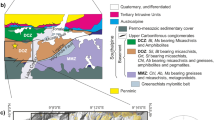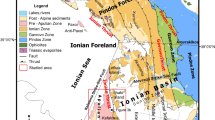Abstract
The currently inactive deep-seated gravitational slope deformation (DGSD) Sagspitz in Tyrol, Austria, covers an area of 3 km2 and originated along a glacially over-steepened slope composed mainly of phyllites belonging to the Innsbruck Quartzphyllite Complex. Past mass movement processes caused the formation of fracture systems and slump bodies which consequently form the aquifers of relatively large springs in a rock type with generally very low permeability and poor porosity. Analysis of water chemistry, oxygen isotope, and field parameters of the springs emerging from the DGSD imply that multilevel aquifers exist and enabled the detection of continuous deep flow paths through the entire length of the mass movement from the main scarp to the toe of the slope. It is shown that the aquifer boundaries and spring emergences throughout the loosened rock mass can be correlated to the internal and basal shear zones of the DGSD so that this hydrogeological approach proved to be useful for evaluating the mass movement structure.












Similar content being viewed by others
References
Agliardi F, Crosta G, Zanchi A (2001) Structural constraints on deep seated slope deformation kinematics. Eng Geol 59:83–102
Ampferer O (1939) Über einige Formen der Bergzerreißung. Sitzungsberichte der Akademie der Wissenschaften Wien. Mathematisch–Naturwissenschaftliche Klasse 148:1–14 (in German)
Barsch D (1997) Rockglaciers. Springer, Berlin Heidelberg New York
Brandner R (1980) Tektonische Uebersichtskarte von Tirol 1:600.000 (tectonic map of Tyrol, scale, 1:600.000). Universitätsverlag Wagner, Innsbruck (in German)
Brückl E, Brückl J (2006) Geophysical models of the Lesachriegel and Gradenbach deep seated mass movements (Schober range, Austria). Eng Geol 83(1–3):254–272
Bundesministerium fuer Land-und Forstwirtschaft, Umwelt-und Wasserwirtschaft (2005) Hydrographisches Jahrbuch von Oesterreich 2002, B 110 (in German)
Bundesministerium fuer Land-und Forstwirtschaft, Umwelt-und Wasserwirtschaft (2006) Hydrographisches Jahrbuch von Oesterreich 2003, B 111, IN PRESS (in German)
Burger U, Millen B, Brandner R (2003) Northern section of the Brenner Base Tunnel: hydrogeological remarks. In: Krásný J, Hrkal K, Bruthans J (eds) IAH procceedings of the international conference on groundwater in fractured rocks, extended abstracts, Prague, Czech Republic, 15–19.09.2003. IHP-VI Series on groundwater no.7, pp 321–322
Clar E, Weiss P (1965) Erfahrungen im Talzuschub des Magnesit Bergbaues auf der Millstätter Alpe. Berg-und Hüttenmännisches Monatsheft (Vienna) 110:447–460 (in German)
Crosta G (1996) Landslide, spreading, deep seated gravitational deformation: analysis, examples, problems and proposals. Geogr Fis Din Quat 19(2):297–313
Cruden DM, Varnes DJ (1996) Landslides: Types and processes. In: Turmer KA, Schuster RL (eds) Landslides investigation and mitigation, special report 247. transportation research board. National Research Council, pp 36–75
Dansgaard W (1964) Stable isotopes in precipitation. Tellus 16:436–468
Decker K, Reiter F, Brandner R, Ortner H, Bistacchi A, Massironi M (2003) Die Evaluierung tektonischer Risikozonen als Planungsgrundlage für den Brenner–Basistunnel. In: Rockenschaub M (ed) Geologische Bundesanstalt, Vienna. Tagungsband Arbeitstagung Brenner 3:249–253 (in German)
Ehalt D, Knott K (1965) Kinetische Isotopentrennung bei der Verdampfung von Wasserdampf. Tellus 17:389–397 (in German)
Epstein S (1956) Variations of the O18/O16 ratios of fresh water and ice. Nuclear Science series, report no. 19, Natl Acad Sci, pp 20–25
Ferrucci F, Amelio M, Sorriso-Vlavo M, Tansi C (2000) Seismic prospecting of a slope affected by deep-seated gravitational slope deformation: the Lago Sackung, Calabria, Italy. Eng Geol 57:53–64
Fügenschuh B, Seward D, Mancktelow N (1997) Exhumation in a convergent orogen: the western Tauern Window. Terra Nova 9:213–217
Fürlinger W (1972) Mechanismus einer Hangbewegung in Quarzphylliten und dessen Kontrolle im gefügeäquivalenten Modellversuch. Geologische Rundschau, Stuttgart, 61/3:871–882 (in German)
Grasbon B (2001) Großmassenbewegungen im Grenzbereich Innsbrucker Quarzphyllite, Kellerjochgneis, Wilderschönauer Schiefer, Finsinggrund (Vorderes Zillertal), unpublished masters thesis. Leopold Franzens University, Innsbruck (in German)
Gruber A (2005) Bericht 2004 über geologische Aufnahmen im Quartär der nördlichen Tuxer Alpen auf Blatt Brenner. Jahrb Geol Bundesanst 145(3/4):337–343 (in German)
Haditsch JG, Mostler H (1982) Zeitliche und stoffliche Gliederung der Erzvorkommen im Innsbrucker Quarzphyllit. Geol-Palaeontol Mitt Innsbruck 12:1–40 (in German)
Hermann S, Becker LP, (2000) Tiefreichende Großhangbewegungen im Kristallin der Niederen Tauern, Ostalpen. Verbreitung, Typen und ihr Einfluß auf die Morphogenese alpiner Täler. In: Proceedings of the Geoforum Umhausen conference, 1, Umhausen (in German)
Humer G, Rank D, Trimborn P, Stichler W (1995) Niederschlagsisotopenmessnetz Österreich. Monograph Bd. 52. Umweltbundesamt, Vienna (in German)
Hutchinson JN (1988) General report: morphological and geotechnical parameters of landslides in relation to geology and hydrology. In: Bonnard C (ed) Proceedings of the 5th international symposium on landslides, vol. 1, A. Balkelma, Rotterdam, Netherlands, pp 3–35
Kaiser A, Scheifinger H, Kralik M, Papesch W, Rank D, Stichler W (2002) Links between meteorological conditions and spatial/temporal variations in long-term isotopic records from the Austrian precipitation network. In: International conference “Study of environmental change using isotope techniques,” 23–27 April 2003. C&S paper series, IAEA, Vienna, 13/P, pp 67–77
Kilchmann S, Waber HN, Parriaux A, Bensimon M (2004) Natural tracers in recent groundwaters from different Alpine aquifers. Hydrogeol J 12(6):643–661
Kolenprat B, Rockenschaub M, Frank W (1999) The tectono-metamorphic evolution of Austroalpine units in the Brenner area (Tirol, Austria)—structural and tectonic implications. Tübinger geowissenschaftliche Arbeiten series A 52:116–117
Kralik M, Papesch W, Stichler W (2003) Austrian network of isotopes in precipitation (ANIP) as a tool for assessing good status in groundwater. In: Kralik M, Häusler H, Kolesar C (eds) 1st conference on applied environmental geology (AEG’03) in central and Eastern Europe, Vienna, pp 127–129
Madritsch H (2004) Geologie und Hydrogeologie von Grosshangbewegungen im Innsbrucker Quarzphyllit und ihre wasserwirtschaftliche Bedeutung, unpublished master thesis. Leopold Franzens University, Innsbruck (in German)
Millen BMJ (2001) Aspects of the hydrogeology of a mining region with a focus on the antimony content of the spring-water, Eiblschrofen Massif, Schwaz, Tyrol, Austria. Mitteilungen der Österreichischen Geologischen Gesellschaft (Vienna) 94:139–156
Millen B, Brandner R, Burger U, Poscher G (2003) The essential geology and hydrogeology for 92 km of tunnelling, Austria/Italy. In: Krásný J, Hrkal K, Bruthans J (eds) IAH procceedings of the international conference on groundwater in fractured rocks, extended abstracts, Prague, Czech Republic, 15–19.09.2003. IHP-VI series on groundwater no. 7, pp 361–362
Mook WG (2000) Environmental isotopes in the hydrological cycle, IHP-V technical documents in hydrology, no.39, vol. I-VI. UNESCO/IAEA, Paris/Vienna
Moser M (1994) Geotechnics of large-scale slope movements (Talzuschübe) in alpine regions. In: Proceedings of the 7th international IAEG congress, Lisboa, pp 1533–1542
Moser M (1996) The time dependent behaviour of sagging of mountain Slopes (Talzuschübe). In: Senneset (ed) Proceedings 7th international symposium on landslides. Balkema (Rotterdam) 2:809–814
Moser M, Glumac S (1983) Geotechnische Untersuchungen zum Massenkriechen in Fels am Beispiel des Talzuschubs Gradenbach (Kärnten). Verhandlungen der Geologischen Bundesanstalt (Vienna) 1982/3:209–241 (in German)
Mostler H, Heissel G, Gasser G (1982) Untersuchung von Erzlagerstätten im Innsbrucker Quarzphyllit und auf der Alpeiner Scharte. Archiv für Lagerstättenforschung Geologische Bundesanstalt (Vienna) 1:69–76 (in German)
Noverraz F (1996) Sagging or deep-seated creep: Fiction or reality? In: Senneset K (ed) Proceedings of the 7th international symposium on landslides. Balkema (Rotterdam) 2:821–828
Ortner H (2003) Local and far field stress-analysis of brittle deformation in the western part of the Northern Calcareous Alps, Austria. Geol-Palaeontol Mitt Innsbruck 26:109–136
Patzelt G (1983) Die spätglazialen Gletscherstände im Bereich des Mieslkopfes und im Arztal, Tuxer Voralpen, Tirol.-Innsbrucker Geographische Studien (Innsbruck) 8:35–45 (in German)
Pergher L, Burger U (2004) Measurement of the physical properties of spring water—an easy an efficient tool for the process analysis of mass movements. In: Abstract volume, 10th Interpraevent congress, Riva del Garda, 24.–27.5 2005
Poscher G (1990) Geotechnische und morphologische Untersuchungen im Bereich des Talzuschubes “Lahnstrichbach”/Fügenberg (Zillertal, Tirol). Geol-Palaeontol Mitt Innsbruck 17:39–49 (in German)
Poisel R (1998) Kippen, Sacken, Gleiten: Geomechanik von Massenbewegungen und Felsböschungen. Felsbau 16(3):135–140 (in German)
Radbruch-Hall DH (1978) Gravitational creep of rock masses on slopes. In: Voight B (ed) Rockslides and avalanches, 1, natural phenomena—developments in geotechnical engineering. Elsevier (Amsterdam) 14(17):607–657
Rank D, Spendlinger W, Nußbaumer W, Papesch W, Rajner V (1982) Isotopenhydrologische Untersuchungen am Bespiel der Erlaufquellen. Beiträge zur Geologie der Schweiz. Hydrologie 28(I):225–236 (in German)
Reitner JM (2000) Large scale toppling and sagging-type deformation in the Schober Group (Eastern Tyrol/Austria): mechanics, timing and consequences. Terra Nostra, p 91
Reitner J, Lang M, vanHusen D (1993) Deformation of high slopes in different rocks after Würmian deglaciation in the Gailtal (Austria). Quat Int 18:43–51
Rockenschaub M, Kolenprat B, Nowotny A (2003) Innsbrucker Quarzphyllit Komplex, Tarntaler Mesozoikum, Patscherkofelkristallin. In: Rockenschaub M (ed) Geologische Bundesanstalt, Vienna. Tagungsband Arbeitstagung Brenner 3:41–58 (in German)
Schotterer U, Stocker T, Bürkl H, Hunziker J, Kozel R, Grasso DA, Tripet JP (2000) Das Schweizer Isotopen Messnetz: Trends 1992–1999. Gas Wasser Abwasser Schweiz 10:725–733 (in German)
Selverstone J (1988) Evidence for east–west crustal extension in the Eastern Alps: implications for the unroofing history of the Tauern window. Tectonics 7:87–105
Stichler W, Hermann A (1983) Application of environmental isotope techniques in water balance studies of small basins. In: New approaches in water balance computations. IAHS (Hamburg) 148:93–112
Stichler W, Zojer H (1986) Umweltisotopenmessungen und hydrochemische Untersuchungen als Hilfsmittel für die Erfassung von Quelleinzugsgebieten. Oesterreichische Wasserwirtschaft 38(Heft 11/12):261–266 (in German)
Stini J (1941) Unsere Täler wachsen zu. Geologie und Bauwesen 13:71–79 (in German)
Tollmann A (1977) Geologie von Österreich, Band 3. Franz Deuticke Verlag, Vienna (in German)
Vogel JC, Lerman JC, Mook WG (1975) Natural isotopes in the surface and groundwater from Argentina. Hydrol Sci Bull XX(2):203–221
Weidner S (2000) Kinematik und Mechanismus tiefgreifender alpiner Hangdeformationen unter besonderer Berücksichtigung der hydrogeologischen Verhältnisse, unpublished PhD thesis. Friedrich Alexander University, Erlangen (in German)
Yehdegho B, Reichl P (2002) Recharge areas and hydrochemistry of carbonate springs issuing form Semmering Massif, Austria, based on long term oxygen-18 and hydrochemical data evidence. Hydrogeol J 10:628–642
Zischinsky U (1969a) Über Sackungen. Rock Mech (Vienna) 1:30–52 (in German)
Zischinsky U (1969b) Über Bergzerreißung und Talzuschub. Geologische Rundschau (Stuttgart) 58(3):974–983 (in German)
Acknowledgement
The authors are in debt to G. Poscher, K. Krainer, and L. Pergher for their scientific advice and help during the early stages of the manuscript. We would also like to thank C. Spötl for his later input and advice. Thanks also go to the reviewers of this paper for their helpful corrections and suggestions. Furthermore, we are grateful for the financial aid of the ILF Consulting Engineers and the Austrian Geological Survey (M. Rockenschaub); the Department of Hygiene, Microbiology, and Social Medicine, University of Medicine Innsbruck (I. Jenewein) for carrying out the hydrochemical and δ18O measurements, as well as the Institute of Geology and Palaeontology, Leopold Franzens University, Innsbruck (C. Spötl), for the δ18O measurements.
Author information
Authors and Affiliations
Corresponding author
Rights and permissions
About this article
Cite this article
Madritsch, H., Millen, B.M.J. Hydrogeologic evidence for a continuous basal shear zone within a deep-seated gravitational slope deformation (Eastern Alps, Tyrol, Austria). Landslides 4, 149–162 (2007). https://doi.org/10.1007/s10346-006-0072-x
Received:
Accepted:
Published:
Issue Date:
DOI: https://doi.org/10.1007/s10346-006-0072-x




